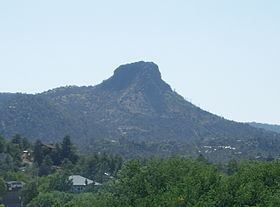Elevation 7,626 ft (2,324 m) Country United States of America | Length 16 mi (26 km) NW-SE | |
 | ||
Region ((northwest)-Arizona transitionzone) Borders on Skull Valley -WSanta Maria Mountains-NWChino Valley & Valley-NNEWilliamson Valley-NELonesome Valley-ENEPrescott, Arizona-EBradshaw Mountains-SE-(attached)Weaver Mountains-SW Communities | ||
The Sierra Prieta is a 14-mi (23 km), long mountain range in central-northwest Arizona. The range is the mountainous region west of Prescott, with prominent Thumb Butte, 6,514 feet (1,985 m), a volcanic plug, on the city's west perimeter.
Contents
Map of Sierra Prieta, Arizona 86305, USA
The range is attached to the northwest of the Bradshaw Mountains, and Granite Mountain, a recreation site, as well as a rockclimbing location, is part of the range's northeast section, overlooking Williamson Valley, further northeast.
The Sierra Prieta range is adjacent the northwest perimeter of the Arizona transition zone, mostly known by its perimeter Mogollon Rim.
DescriptionEdit
Sierra Prieta is a mostly northwest by southeast section of mountains. The highest peak in the south is Mount Francis, 7,110 feet (2,167 m), which borders the Bradshaw Mountains; Arizona State Route 89 traverses between the two mountain ranges.
The range highpoint is Granite Mountain, 7,626 feet (2,324 m), anchoring the range's N & NNE; it is separated from the central section by Little Granite Mountain, 7,082 feet (2,159 m) to the southwest, and by Tonto Mountain, 5,631 feet (1,716 m), which is due west. Two other peaks form the range's center, West Spruce Mountain, 7,160 feet (2,182 m), and Williams Peak, 7,055 feet (2,150 m).
RoutesEdit
Besides Arizona 89 going southwest from Prescott between the Bradshaw Mountains, County 10 rises to Iron Springs, (Iron Springs Pass) in the range's north. It is often used as a shorter route through the lower elevation Skull Valley during winter snowstorms.
NotableEdit
The Sierra Prieta range is known in cowboy camps around the world as "The Sierry Petes" a colloquial and period pronunciation of the name made famous in the cowboy poem by the same name but more widely known as "Tyin' A Knot In The Devil's Tail" by Arizonan, Gail Gardner.
